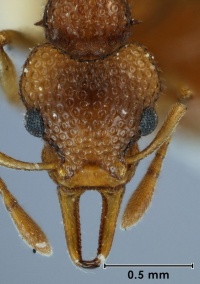Epopostruma sowestensis
| Epopostruma sowestensis | |
|---|---|

| |
| Scientific classification | |
| Kingdom: | Animalia |
| Phylum: | Arthropoda |
| Class: | Insecta |
| Order: | Hymenoptera |
| Family: | Formicidae |
| Subfamily: | Myrmicinae |
| Tribe: | Attini |
| Genus: | Epopostruma |
| Species: | E. sowestensis |
| Binomial name | |
| Epopostruma sowestensis Shattuck, 2000 | |
The only known collection of this species was made using pitfall traps. The specimens came from Kojonup, in the southern wheatbelt (WA).
Identification
This species has expanded, wing-like lateral extensions of the postpetiole. It is similar to Epopostruma mercurii but differs in that E. sowestensis has the petiolar spines indistinct and reduced to sharp angles while in E. mercurii these spines are well developed and distinct. In addition, E. sowestensis has distinct flanges connecting the bases of the propodeal spines and propodeal lobes while E. mercurii lacks these flanges.
Keys including this Species
Distribution
Latitudinal Distribution Pattern
Latitudinal Range: -33.83333333° to -33.83333333°.
| North Temperate |
North Subtropical |
Tropical | South Subtropical |
South Temperate |
- Source: AntMaps
Distribution based on Regional Taxon Lists
Australasian Region: Australia (type locality).
Distribution based on AntMaps
Distribution based on AntWeb specimens
Check data from AntWeb
Countries Occupied
| Number of countries occupied by this species based on AntWiki Regional Taxon Lists. In general, fewer countries occupied indicates a narrower range, while more countries indicates a more widespread species. |

|
Estimated Abundance
| Relative abundance based on number of AntMaps records per species (this species within the purple bar). Fewer records (to the left) indicates a less abundant/encountered species while more records (to the right) indicates more abundant/encountered species. |

|
Biology
|
Castes
Nomenclature
The following information is derived from Barry Bolton's Online Catalogue of the Ants of the World.
- sowestensis. Epopostruma sowestensis Shattuck, in Bolton, 2000: 58 (w.) AUSTRALIA.
Type Material
- Holotype, worker, Kojonup, Western Australia, Australia, R.E & R.G., ANIC32-003773, Australian National Insect Collection.
Unless otherwise noted the text for the remainder of this section is reported from the publication that includes the original description.
Description
In full face view the lateral margin of the head between the eye and the posterior corner generally angular. Pronotal spines present, short. Posterior section of metanotum in approximately the same plane as the dorsal face of propodeum, the junction of these plates either indistinct or in the form of a shallow trough or depression. Posterior face of propodeum with broad, distinct flanges which connect the bases of the spines to the propodeal lobes. Petiolar spines indistinct, reduced to sharp angles. Anterior face of postpetiole slightly longer than the dorsal face; sides of postpetiole expanded laterally in the form of thin, solid wings, their lateral margins flat; posterolateral margin of postpetiole (immediately anterior of gaster) weakly concave. Dorsum of petiole, postpetiole and gaster with straight or weakly curved erect hairs. First gastral tergite smooth. Body colour yellow-red; dorsal surface of head weakly infuscated; ventral regions of head, mandibles, antennae and legs slightly lighter; gaster uniform golden brown.
Measurements
Holotype worker. TL 4.1mm, HL 0.85mm, HW 0.82mm, CI 96, MandL 0.45mm, MandI 53, SL 0.53mm, SI 65, PronW 0.50mm, ML 1.02mm.
References
- Heterick, B. E. 2009. A guide to the ants of South-western Australia. Records of the Western Australian Museum, Supplement 76:1-206.
- Heterick, B.E. 2021. A guide to the ants of Western Australia. Part I: Systematics. Records of the Western Australian Museum, Supplement 86, 1-245 (doi:10.18195/issn.0313-122x.86.2021.001-245).
- Heterick, B.E. 2022. A guide to the ants of Western Australia. Part II: Distribution and biology. Records of the Western Australian Museum, supplement 86: 247-510 (doi:10.18195/issn.0313-122x.86.2022.247-510).
- Shattuck, S. O. 2000. Genus Colobostruma. Genus Mesostruma. Genus Epopostruma. Pp. 31-67 in: Bolton, B. The ant tribe Dacetini. Mem. Am. Entomol. Inst. 65: 1-1028 (page 63, worker, queen described)

